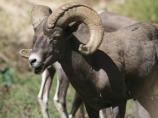Bighorn sheep were once common in Southern California and Nevada, but after more than a century of impacts from disease, unregulated hunting, and habitat loss, their numbers were in sharp decline. Since the 1960s, cooperative efforts from state and federal agencies to rebuild the herds were paying off, but now a disease outbreak at Joshua Tree National Park could pose a major threat to the majestic animals.
The first report of a sick and coughing bighorn was reported in early May this year very near to the community of Joshua Tree, CA. For a while, only occasional reports were received of sick animals ranging from Fortynine Palms Canyon to the Maze Loop area. However, in mid-August, a dead lamb was found in the park and sent to a disease lab for necropsy.
Results of laboratory analysis of blood and tissue samples showed that this animal was infected with pneumonia. In other instances, the mortality rate for animals infected with the disease has been 50 to 90 percent, and there is no vaccine or cure. At this time it is unknown what mortality will be among Joshua Tree's herds. This form of pneumonia is not transmissible to humans.
The disease may enter into a wild population from domestic sheep or goats. Biologists caution the public to avoid releasing domestic sheep or goats into the wild as they often are disease carriers even if they have no symptoms. Desert bighorn often have no natural defenses to diseases carried by domestic animals.
That lack of natural resistance may result in high infection and death rates in bighorn populations. The few animals that survive may become carriers, infecting new lambs that often die within a few months of birth. An outbreak such as this one typically causes a long term decline in the population that can last for more than a decade.
Biologists have formed an interagency group to monitor disease outbreaks, suggest best practices for limiting effects of the disease, and provide recommendations for management actions. Members of the group represent the California Department of Fish and Wildlife, Nevada Department of Wildlife, National Park Service, and many affiliated researchers from the USGS and Oregon State University.
Frequently Asked Questions
How many bighorn sheep are in Joshua Tree? Scientists estimate there were 200 to 300 desert bighorn in the park before this disease outbreak.
How did pneumonia enter the desert bighorn herd? Pneumonia can be transmitted to bighorn from domestic sheep and goats. No one knows for certain how this particular disease outbreak started. Desert bighorn have few natural defenses to diseases carried by domestic animals. The public should avoid releasing domestic sheep or goats into the wild, as they can be disease carriers even if they have no symptoms.
Can this disease be transmitted to humans? No. But visitors should not touch dead or dying wildlife. Report any sick or dead bighorn to a ranger.
Can this disease spread into other herds outside Joshua Tree National Park? Yes, the disease can spread to other herds. Bighorn are social animals that frequently move between herds throughout the year. Herds outside of the park are also susceptible to contracting pneumonia from domestic animals whenever there is contact.
How can I help? Reporting any sick, coughing or dead bighorn is important to the monitoring of the disease and its spread throughout the park. Tell a ranger at any entrance station or visitor center, or call us at 760-367-5500.
Last updated: October 8, 2015

